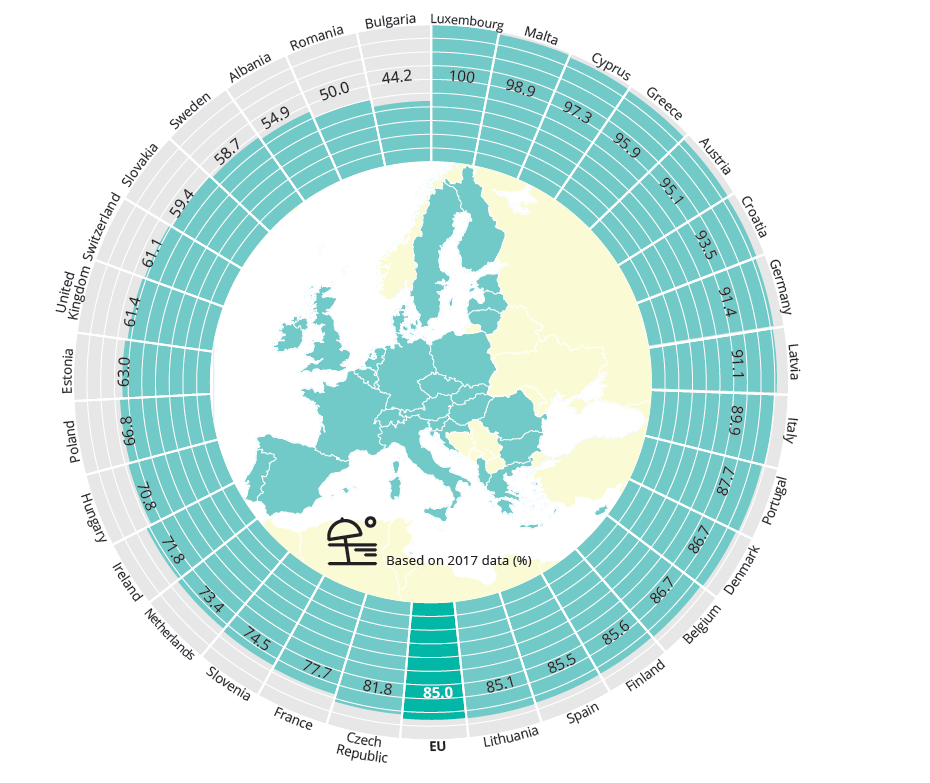Nearly all 21.801 bathing water sites monitored last year across Europe, of which 21.509 were in the 28 EU Member States (95.9%), met the minimum quality requirements under EU rules according to the report by the European Environment Agency (EEA) and the European Commission. Albania and Switzerland also monitored and reported on the quality of their 292 bathing water sites.
Specific results from monitoring showed a small drop in EU sites meeting the highest 'excellent' and the minimum quality requirements set out by the EU's Bathing Water Directive. 'Excellent' quality standards across Europe dropped marginally from 85.5% in 2016 to 85% last year. Similarly those meeting minimum 'sufficient' standing fell from 96.3% to 96.0%. The reason for the slight drop was due mostly to the effect of summer rain on test results as well as changes in testing methodology in Romania and Sweden.
The number of overall 'poor' rated sites remained mostly unchanged from 2016 across the EU, Albania and Switzerland, dropping from 1.5% in 2016 to 1.4% in 2017.
Karmenu Vella, European Commissioner for the Environment, Maritime Affairs and Fisheries, said: "The quality of our bathing water is a source of pride for Europeans. That quality is due to good cooperation and constant vigilance. We all play a part: industry, local authorities and services together with citizens. We are happy to report that the European spirit of cooperation on bathing water is alive and continues to deliver for our citizens. When you add in our recently proposed measures to keep plastics out of our seas, it really has been a good year for European seas, beaches and lakes."
Hans Bruyninckx, EEA Executive Director, said: "Reducing water pollution benefits the well-being of European citizens but also animals and plant life. But we cannot be complacent. Keeping our bathing water clean requires our sustained attention by policy makers. That is why regular monitoring and assessment of bathing sites remains a crucial task."
Europe's bathing water quality has vastly improved over the last 40 years, when the EU's Bathing Water Directive was introduced. Effective monitoring and management introduced under the directive led to a drastic reduction in untreated or partially treated municipal and industrial waste water ending up in water. As a result, more and more bathing water sites are not only meeting the minimum quality standards, but have also improved their quality to the highest standards. Alongside this year's report, the EEA has also released an updated interactive map showing the performance of each bathing site. Updated country reports are also available here as well as more information on the directive.

Other key findings:
- In five countries, 95% or more of bathing waters were assessed as being of excellent quality: Luxembourg (all 12 reported bathing waters), Malta (98.9% of all sites), Cyprus (97.3% of all sites), Greece (95.9% of all sites) and Austria (95.1% of all sites).
- All reported bathing water sites in Austria, Belgium, Croatia, Cyprus, Greece, Latvia, Luxembourg, Malta, Romania, Slovenia and Switzerland achieved at least sufficient quality in 2017 (in accordance with the minimum quality standards set by the Bathing Water Directive).
- The three countries with the highest numbers of bathing water sites of 'poor' water quality were Italy (79 bathing water sites or 1.4%), France (80 sites or 2.4%) and Spain (38 sites or 1.7%). In the EU Member States, the highest proportion of bathing waters classified as 'poor' was recorded in Estonia (four bathing waters or 7.4%), Ireland (seven bathing waters or 4.9%) and the United Kingdom (21 bathing waters or 3.3%).
Background
The contamination of water by faecal bacteria continues to pose a risk to human health, especially if it is found at bathing water sites. Swimming at contaminated beaches or lakes can result in illness. The major sources of pollution are sewage and water draining from farms and farmland. Such pollution increases during heavy rains and floods due to sewage overflow and polluted drainage water being washed into rivers and seas.
All EU Member States, plus Albania and Switzerland, monitor their bathing sites according to the provisions of the EU's Bathing Water Directive. The assessment of the bathing water quality under the Bathing Water Directive makes use of the values of two microbiological parameters: Intestinal enterococci and Escherichia coli. The legislation specifies if the bathing water quality can be classified as 'excellent', 'good', 'sufficient' or 'poor', depending on the levels of faecal bacteria detected. Where water is classified as 'poor', Member States should take certain measures, like banning bathing or posting a notice advising against it, providing information to the public, and taking suitable corrective actions.
Document Actions
Share with others